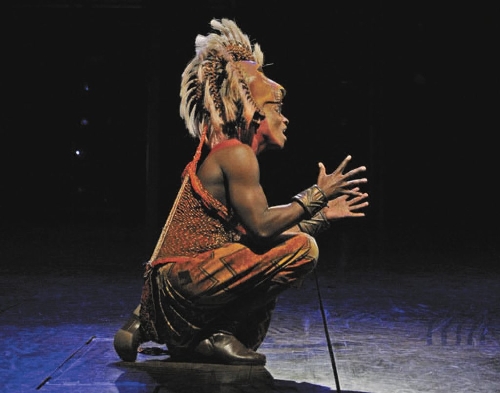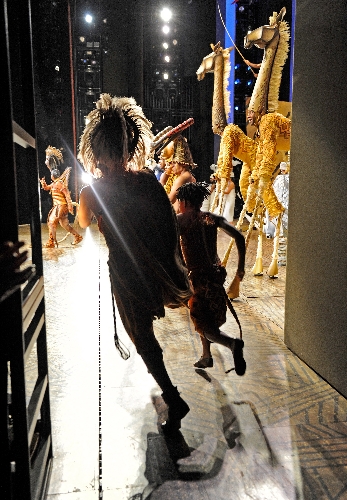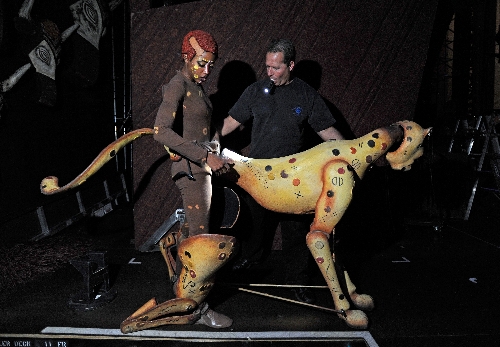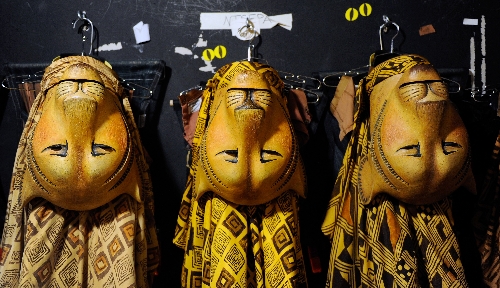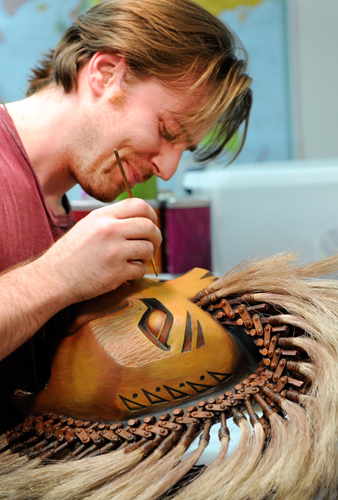Organized backstage action keeps ‘Lion King’ crew on toes
Amid the backstage chaos of "The Lion King's" opening number, a ministorm brewed.
A performer pulled a hamstring while dancing in "The Circle of Life" and had to drop out. But they needed him; he appears as a thatch of jungle grass in another number.
That was dance captain Geoff Myers' cue. He dropped what he was doing to don a grass skirt while puppet supervisor Jena Kerr adjusted the headgear -- the important thatch of jungle grass -- to fit Myers' head.
In all, the unplanned cast change took minutes.
"This is the most exciting backstage action we've had in months," stage manager Alison Dingle said of the recent Thursday show.
Of course, Dingle wasn't including the normal backstage action that takes place during every performance of the Disney production. That's old hat to the cast and crew; they celebrate their second anniversary at Mandalay Bay this month.
But it's enough to overwhelm the uninitiated. In a good way.
While the audience sits in the theater enraptured with the sensory feast onstage, a whole other performance is unfolding behind the scenes, in the orchestra pit under the stage, in the wings and down in the bowels of "The Lion King" theater.
It is well-choreographed chaos.
"If someone doesn't do exactly what they're supposed to do, it can throw off everything that comes after," says Derrick Williams, the actor who plays Mufasa. "I think if people could see what goes on backstage, they would be surprised by how choreographed it is."
Five stage managers, one orchestra conductor, 23 musicians, a dance supervisor, three puppet artists, 55 crew members and a cast of 54 are tasked with ensuring that each performance is as sharp as the first.
"Everything about the show is so specific, whether it's about the puppets, the focus on the stage, the lights," says Jeff Norman, whose job as production stage manager is to make everything happen. "It can never be vague. There should be no round edges."
Before the show starts, three stage managers sit in the office they share, planning their upcoming night. Their long-established routine means that the process of staging the show is nearly seamless. But that doesn't mean they don't get butterflies.
"There's always an element of nerves, even when you've called a show for two years," Dingle says.
Obviously, this is the calm before the storm, when actors get their makeup done, put their costumes on, warm up and hang out.
In a small waiting room, the child actors who play young Simba and Nala watch television and play. A sign hangs on the door instructing them, "Don't run when you go out the door." Kid wrangler Lisa Wellington had the children make the sign because they kept running out the door. Wellington is also eating her dinner, getting ready for the night when she will climb the staircase to the stage 24 times, ferrying her charges to their marks and then escorting them back to their room.
In a common area nearby, another sign encourages anyone to take a stab at assembling the jigsaw puzzle scattered on a table. In the makeup room, another child actor who plays Nala -- there are two sets of child actors -- sits in a chair getting her makeup done while explaining the virtues of pineapple on a pizza.
The puppet artists sit in their workroom, eating and repairing puppets. The show features more than 200 puppets, which are designed to be extensions of the actors. Every actor wears at least one while some play multiple characters. Myers, who replaced the injured actor, changes costumes 13 times during one performance.
Once the show begins, the air nearly crackles with energy. Performers run on and off stage, changing costumes. Some actors stand in the wings singing their parts, providing crew members with a live soundtrack to do their nonstop dance of moving set pieces and changing props.
This night has already started off with the excitement of replacing a performer but, when it rains, it pours, says Myers, the dance captain who filled in for the injured man. So it was only fitting that a wardrobe malfunction occur at some point.
That moment came before the scene where a giraffe is pursued by a cheetah. An actor sat on a ladder, putting on his giraffe costume, which consists of four stilts for giraffe legs, a jumpsuit and a giraffe head. The jumpsuit zipper broke. There wasn't time to fix the zipper.
A crew member jumped on the radio to relay the information to the crew on the other side of the stage who would help the actor take off his costume.
"When you get ready to take off his giraffe jumpsuit, the zipper is in my hand," the crew member says.
"OK, I'll just move carefully," the giraffe says. The audience never knew.
By the end of the show, it's obvious that, as much work as they've done, the cast and crew have also enjoyed themselves. They high-five each other, dance together, share little in-jokes with their co-workers. "As serious as it is out there," Williams says, "you've got to have some fun."
Contact reporter Sonya Padgett at spadgett @reviewjournal.com or 702-380-4564.
Preview
"The Lion King"
7:30 p.m. Mondays through Thursdays, 4 and 8 p.m. Saturdays and Sundays
Mandalay Bay Theatre, 3950 Las Vegas Blvd. South
$64-$168.50 (632-7777)



